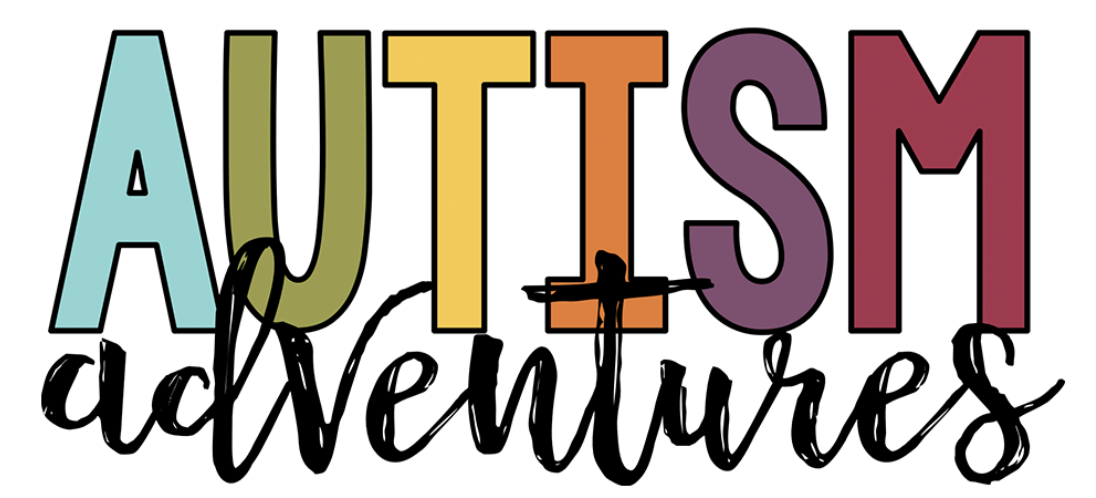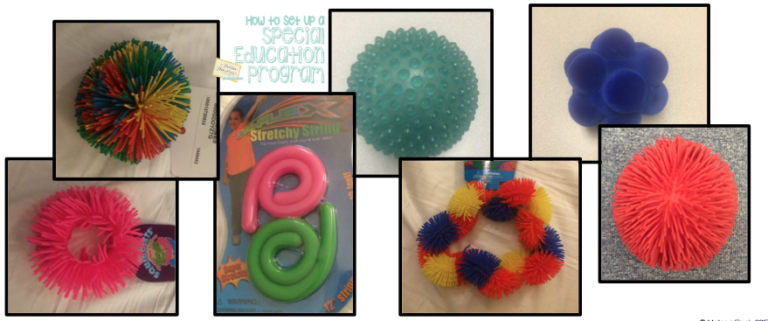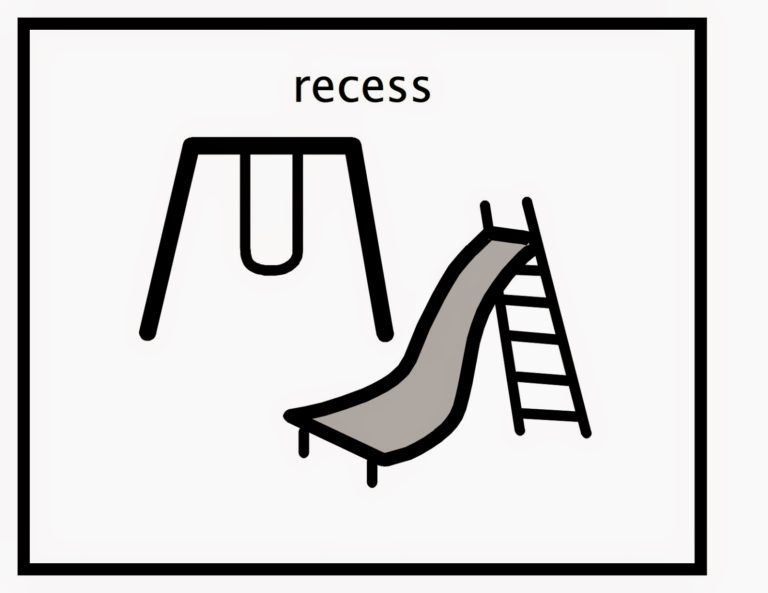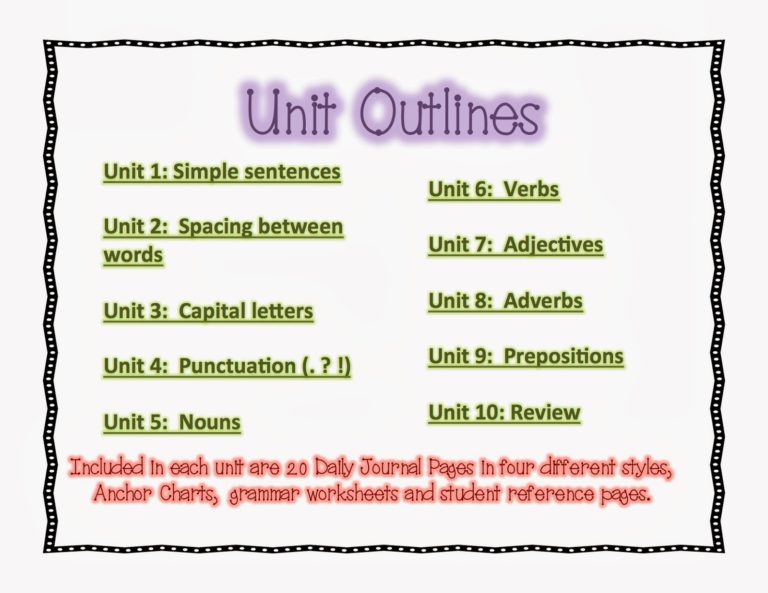How to Set Up A Special Education Classroom
One of the most common questions asked of me is, “How do I set up my special education classroom?” As with everything, there is no one-size-fits-all approach. A variety of factors will affect how your classroom is set up. However, we can look at best practices to set up the best classroom to meet the individual needs of our students. This post will be helpful for both new teachers just starting and veteran teachers looking to change up their program for the new school year.
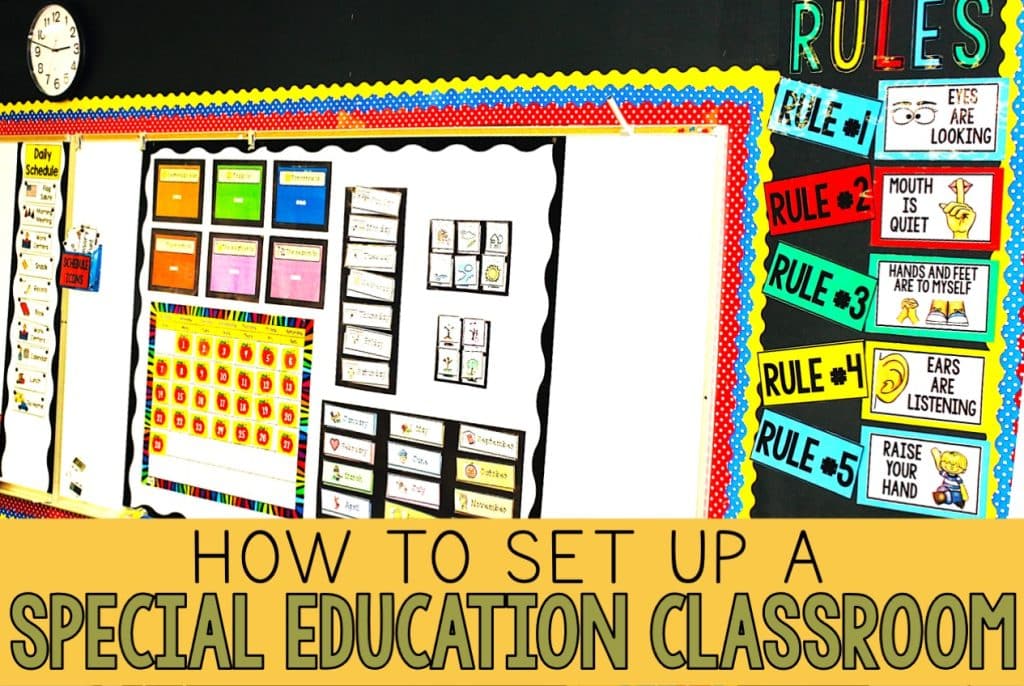
I have a round up post today linking to a variety of blog posts that will help you set up your Special Education Program. By the end of this post you will have all the tools you need to build an inclusive classroom that will provide a safe space for students. You will know how to build a well-organized classroom that will work cohesively with other special education services providers.
Todays Post will cover:
- Classroom Floor Plan
- Bulletin Board Ideas
- Sample Daily Schedule
- Morning Meeting Routine
- Calendar Routine
- How to Run Work Center Rotations
- Visual schedules
- Visual supports
- How To Set Up the Best Calm Down Kit for Your Classroom
- social emotional learning curriculum
- Effective Communication Skills in the Classroom
- How to Teach Life Skills
- Sensory Integration
Classroom Floor Plan for special education classroom setup
The first step in setting up your classroom is creating the physical layout of your classroom. There are a few simple steps you can do to maximize your classroom with the furniture you are able to get your hands on. The classroom floorpan sets the tone for all visual supports and visual aides you will be utilizing throughout your classroom as well. It can also create natural physical boundaries within your classroom to minimize distractions and maximize student efficiency. If done correctly, you can strategically use your floorpan to encourage a successful year.
A special education classroom setup layout can be built to include different areas to meet the needs of your students. You classroom floor plan will include a whole group area, individual desks, independent work area, play area, teacher desk, work center tables and work systems. I have a very detailed blog post that provides you a step by step guide to setting up your classroom floorpan. To read that post and follow along with that guide, click HERE.
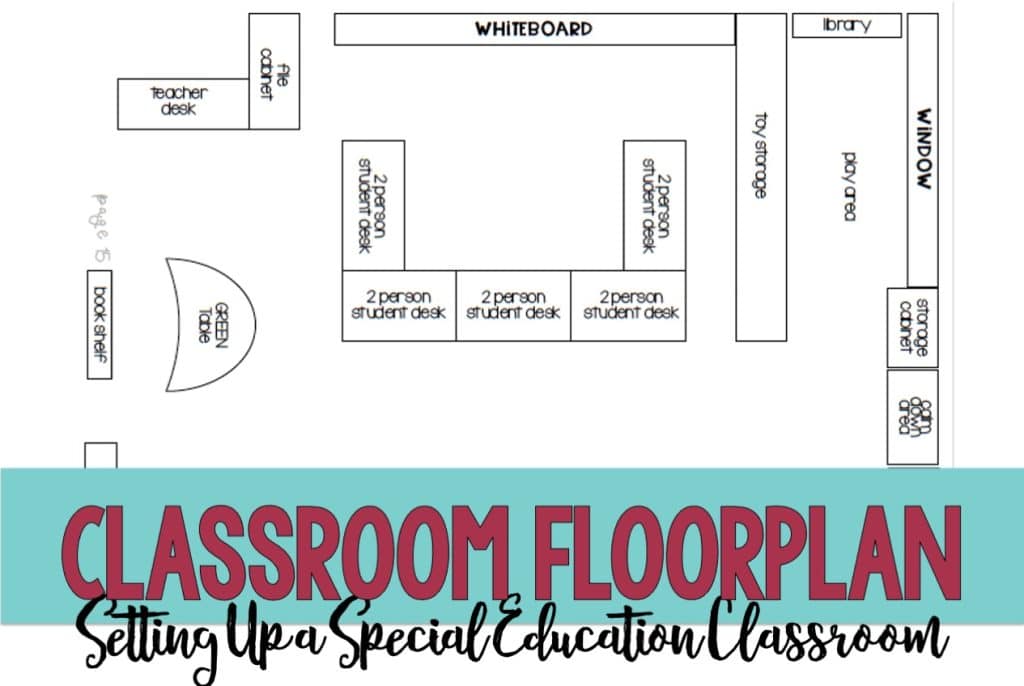
Best Bulletin Board Ideas for a Special Education Classroom
Bulletin boards can be used as visual supports to support your students throughout the day. It is important to utilize wall/cabinet space with bulletin boards and visual supports that will add to the success of your students, not distract them. When setting up bulletin board in your classroom, you want to make sure you are providing visual cues and avoiding visual clutter.
Before you map out your bulletin boards, think about what visual supports your students will be requiring to be successful this year. It is also important to review IEP’s at this time to see what visual supports are required to meet the needs of your students.
Here is a list of common classroom bulletin boards and visual supports that are often found in a special education program that can be a great way to support students within their school day.
- Daily Schedule
- Individual Visual Schedules
- Behavior Supports
- Student Work
- TEACCH Independent Work Station Visuals
- Morning Meeting Bulletin Board/Visuals
- Calendar Routine Bulletin Board
- Classroom Rules/Classroom Expectations (grab this freebie)
- Teacher Organization/Staff Schedules
- Curriculum Support such as Language Arts and Math Charts
- Sight Word Wall (grab this freebie!)
- Adapted Book/Library Organization
To learn more about these common bulletin boards, read an in depth blog post (WITH PICTURES!) CLICK HERE.
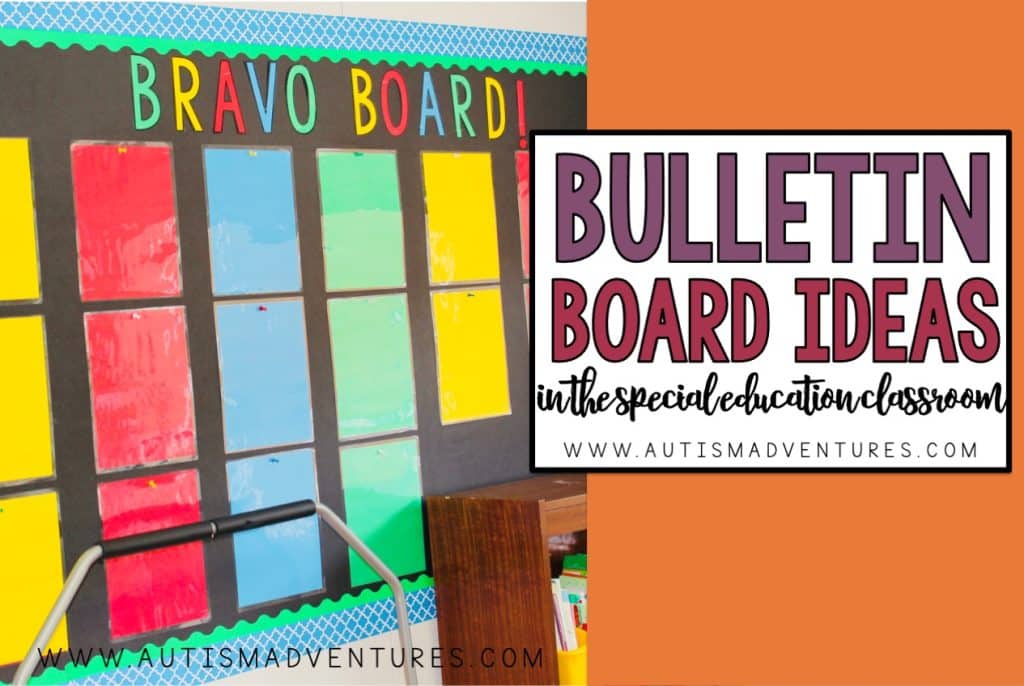
Sample Daily Schedule
The most common question I get asked is, what is your daily schedule? I wish it could be a one size fits all answer so that I could set your schedule for you. For obvious reasons, it’s going to be different for every classroom. Different classes have different needs, different requirements and different activities.
Setting up a classroom schedule is no easy task for any special education teacher. Start with your non-negotiables such as school specials such as PE, computer lab, library and music. For me, at my old school, these are assigned and could not be changed. Same goes for recess and lunch times. After this, start working on your master schedule to build your daily routines.
From here, you are going to block your day into chunks of open time. Find your big chunks of time where you will be able to incorporate core instruction for your students in work centers. This is also where you will need to review student IEP’s and make a master list of all student services. Set this aside and keep in mind when mastering your schedule. Will your students have whole group services such as speech or adapted physical education? If so, consult with the service providers as soon as you can to get a time slot that works for your students. Individual services will be sprinkled in at times that works for both you and the service providers.
Setting up your schedule is like a big puzzle, one thing affects the other. Starting with non-negotiables is the simplest way to complete your master schedule. To read detailed post about the daily schedule I created in my classroom, click HERE .

Morning Meeting Routine
Morning meeting is one of my favorite times in the classroom because we all come together to greet one another to start the day. Sometimes the natural conversations that spark during morning meeting are some of the best we have as a class. I taught older students, so I always referred to it as morning meeting. If you teach younger students, this same part of your day may be called circle time.
Morning meeting is a great way to build social skills and a variety of life skills to start the day. It is my favorite time of day because its a slow and intentional start to our day. My morning meeting activities change daily but also follow the same routine each day. To start off morning meeting, we sing goodmornig songs. There are a variety of morning songs that I have found over the years on Spotify, Apple Music and You Tube. If you have an interactive whiteboard, you can play some YouTube morning dance/brain break videos to start the day if you want to get some movement in.
Within our morning meeting routine I would take attendance, greet each student, ask a question or two, and review the daily schedule for the day. Morning meeting can be magic in your classroom. Don’t breeze over it as a time filler activity, maximize the potential of it! I have a very detailed blog post, full of pictures and a video modeling the routine, in this post HERE.
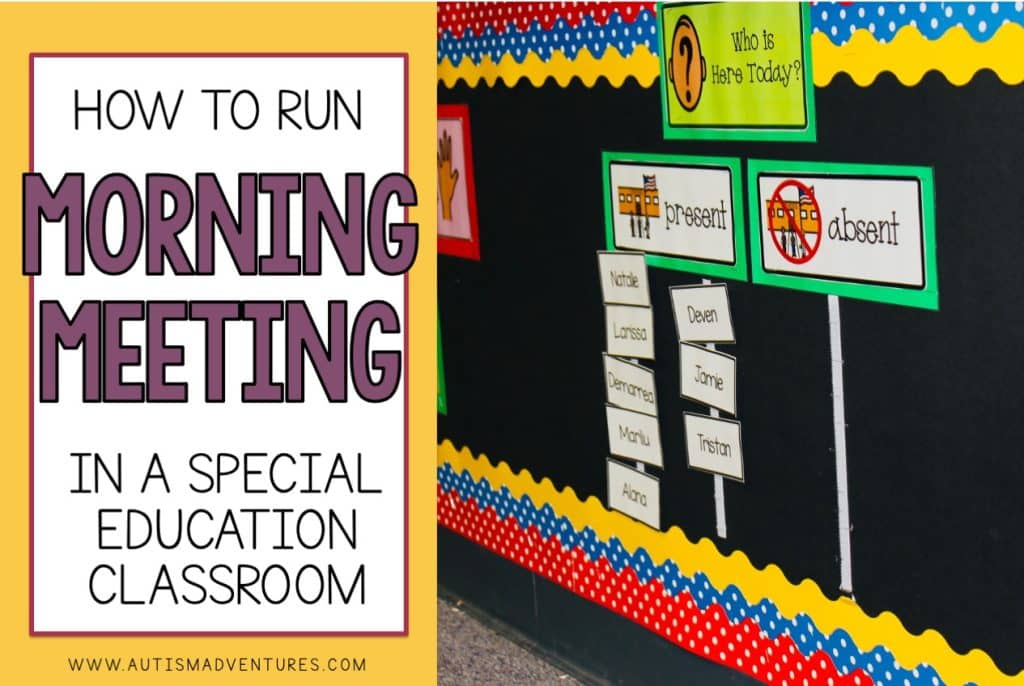
Calendar Routine
Calendar skills is a very important life skills all students must master. How you teach calendar will greatly vary depending on the needs and abilities of your students. When I was in the classroom, I created a differentiated routine so that all students could participate at their own level.
Here are all of the variations I use during my calendar routine that get daily use!
- Calendar Books
- Calendar File Folder
- Calendar Board
- Fill in the Blank Worksheet
- Circle the Answer Worksheet
- Interactive Calendar PDF
To get a very detailed overview about my differentiated calendar routine, click HERE. This post is full of pictures and a video walk through showing my calendar routine in my classroom.
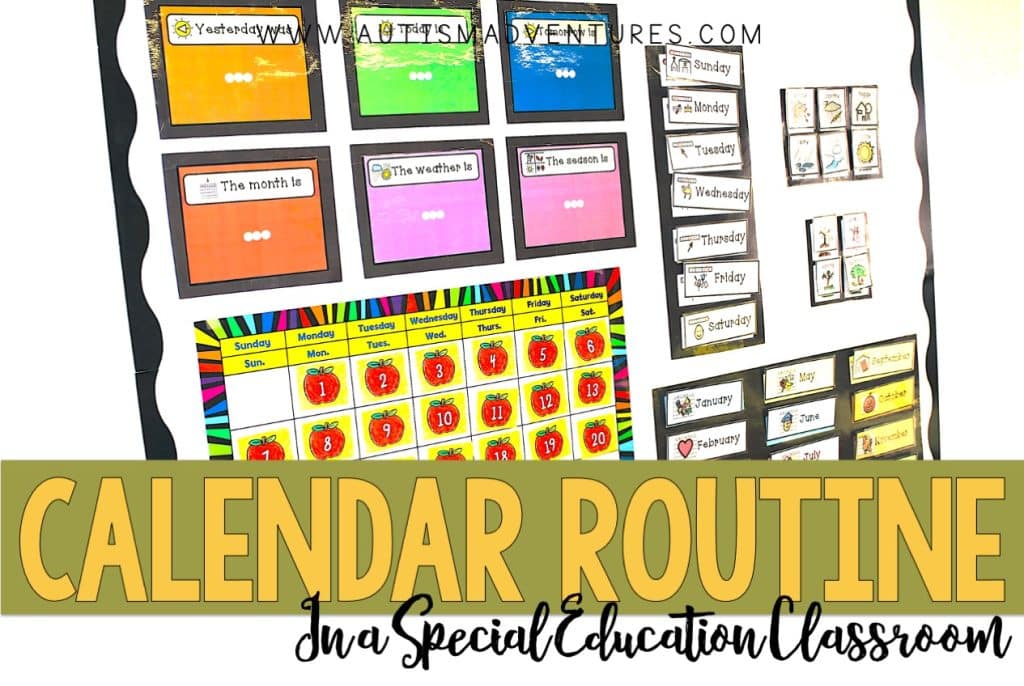
How to Run Work Center Rotations
Over the years, I have fine tuned my work center system to make it efficient for students with special needs. The systems in place to run rotations start on the first day of school and continue every day of the school year. The expectations within each center can change daily and progress as students master new skills. I love my work center rotations because it promotes independence within your daily schedule.
I have set up my rotations using a color coding system. In my classroom I had three work centers within the rotations where I could provide instruction to small groups. I had a “blue table,” “red table,” and “green table.” These work areas are where my core instruction took place.
work center visuals
Each table is clearly labeled with colored acrylic dots. These colored spots can be written on with dry erase markers too! You can grab them on amazon HERE. Each table also has a colored sign labeling each table hanging from the ceiling. Also, behind each table is a bulletin board matching the color of the table. There is no confusion knowing where each colored work center is in my classroom!
The class was broken up into small groups and these small groups rotated between centers together. Working cards, shown below, are carried by the student from table to table with each transition between activities. Each groups card has visual cues on the bottom of their card. The cues tell the different groups of students which order of work center tables they will be visiting. For example, 1st Red Table, 2nd Green Table, 3rd Blue Table. At the end of the work center rotations, students earned a preferred toy or activity.
I have a very detailed blog post outlining how I set up my work center rotations full of pictures and also a video walk through. To learn more, click HERE.
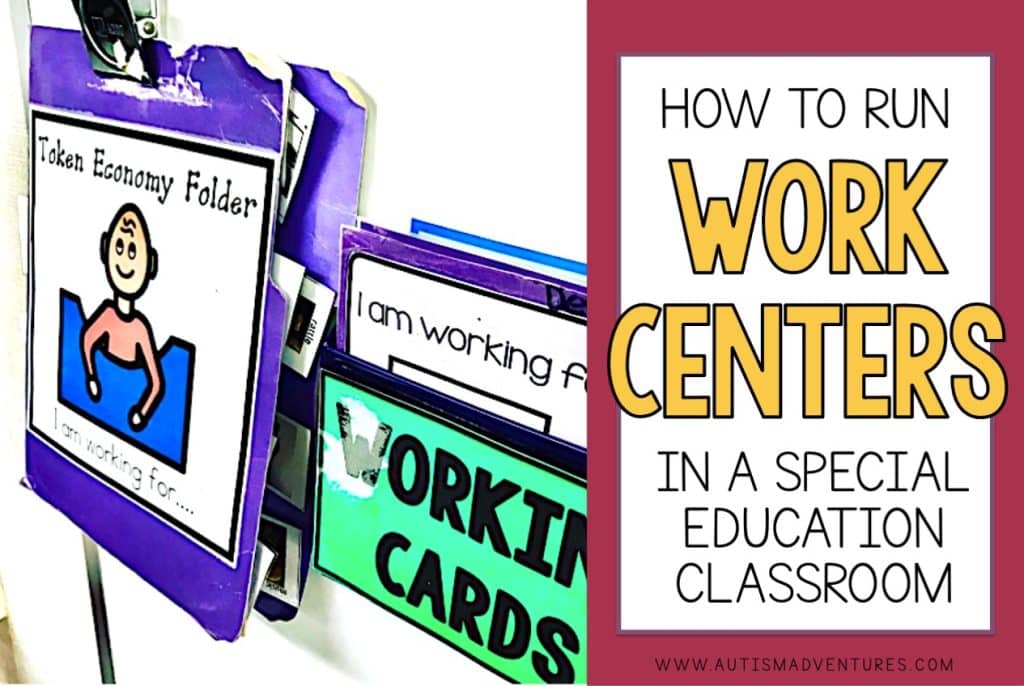
Visual schedules
Visual schedules are visual supports to help students become independent within the classroom setting. They display the daily schedule and help with smooth transitions within the classroom. There are a variety of ways you can set up your visual schedule depending on your students’ needs.
A visual schedule is a list of activities that will be happening within your school day. Essentially, it is a daily schedule full of visual cues of different kinds to help students understand the schedule on their own. It is an effective way to minimize transition confusion.
The importance of utilizing visual schedules in a special education classroom is well researched and well proven to be successful. With that being said, every classroom must
utilize a wide range of visual schedules to help their students be successful. Depending on the student’s needs, different types of schedules can be used by special education teachers.
Below are the different types of visual schedules that can be used in special education classrooms and school settings:
To get an in depth overview on each type of schedule listed above, click HERE to read the full post.
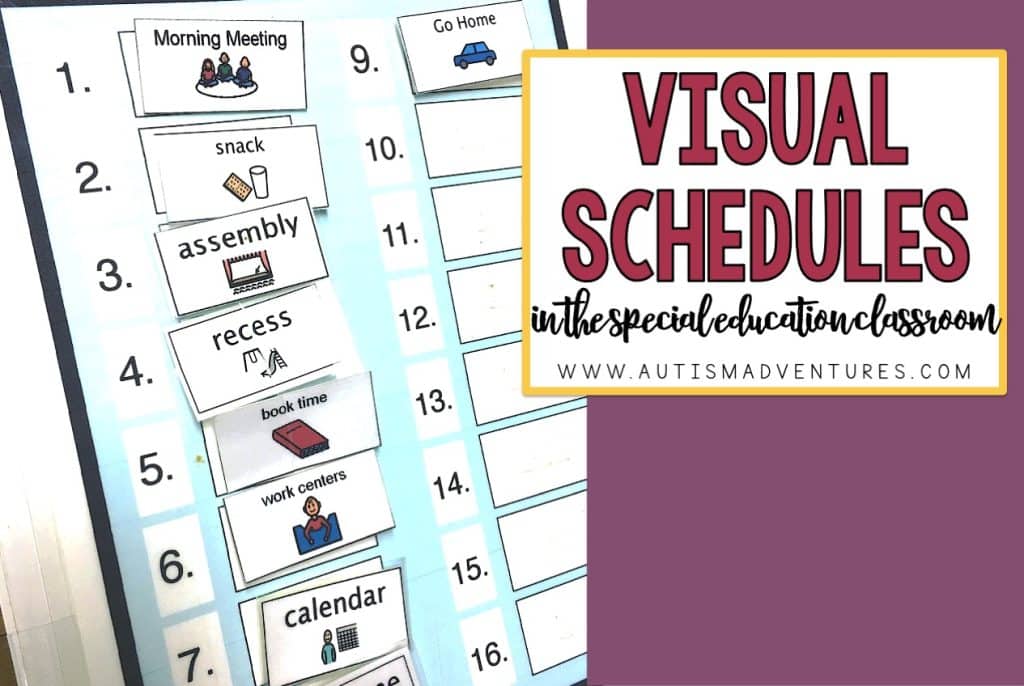
Visual supports
Visual supports are a some of the best ways to build independence within your special education classroom. Students thrive off of visuals and visual aids. Visual supports help with classroom management and help support your daily routine. Visual supports can be used in a variety of situations and over time you can build your collection of visual supports.
The use of visuals are a great way to build independence, increase student success and provide individualized support where needed. The use of visuals in a special education classroom is evidence-based practices for students with special needs. There are many different ways you can utilize visuals in your classroom, and we are going to discuss them today!
VISUAL SUPPORTS TO USE IN YOUR SPECIAL EDUCATION CLASSROOMS:
- Technology visuals (GRAB THESE FOR FREE!)
- Work center visuals
- Lining up spots
- Visual rules (GRAB IT FOR FREE!)
- Schedules
- Emotions visuals
- Individualized Visuals
- Calm down corner
- Calm down kit
- Transitions/timers
- Breathing Visuals (GRAB THESE FOR FREE!)
- Break Visuals
- Social Stories
- Working Cards
- First/Then Boards
- Voice Volume Levels
- Table Tools
To read a more in-depth description and pictures of each visual support listed above, head to my post about Visual supports HERE.
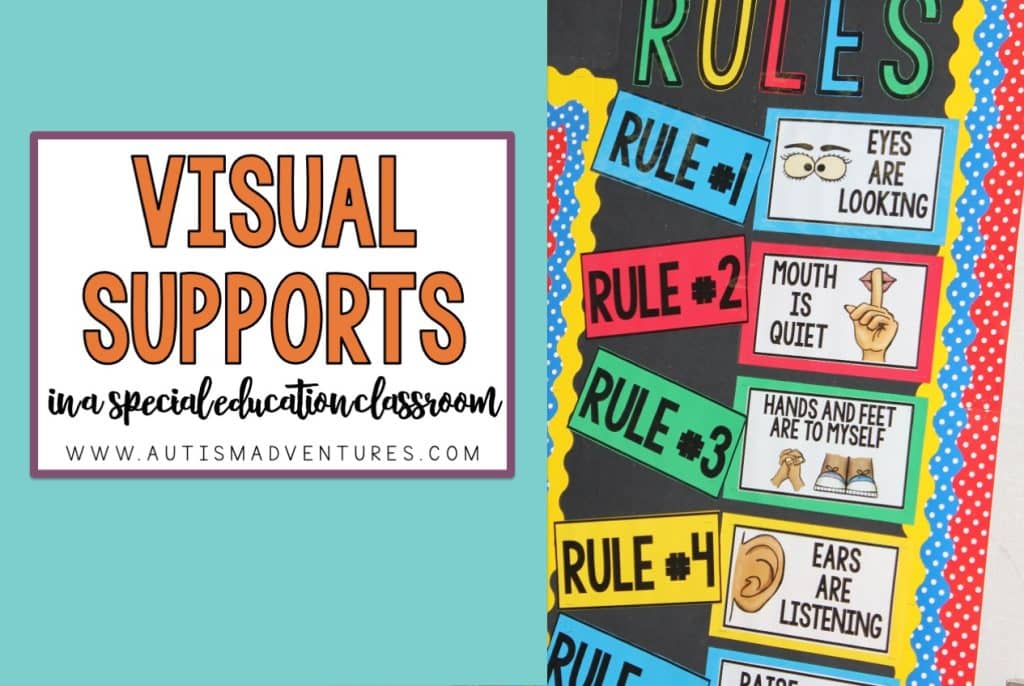
How To Set Up a special education classroom with the Best Calm Down Kit
A big job of special education teachers is teaching students to identify their emotions, regulate their emotions and be successful and independent within the school day. Teaching students to understand their emotions, and the emotions of their peers, will help with your classroom management.
Calm Down Kit
Calm down kits in the classroom are an invaluable resource for supporting emotional regulation and creating a supportive learning environment. They typically include various tools and activities created to help students manage their strong emotions and stress levels. From sensory objects like stress balls and fidget spinners to mindfulness exercises such as deep breathing techniques and guided meditation scripts, the contents of these kits are designed to meet the needs of your students. Implementing calm down kits not only prepares students with coping strategies but also empowers them to take ownership of their emotional well-being. By providing a safe space for students to navigate their feelings, special education teachers can create a positive classroom atmosphere conducive to learning and growth.
Calm Down Corner
A calm down corner in a special education classroom is a designated area designed to provide students with a safe and supportive space. In this space they are able to regulate their emotions and regain a sense of calmness. It usually has various sensory tools to meet the sensory needs of your students. Additionally, the calm down corner usually will have visual tools to help students identify and express their feelings. Teachers often teach students coping strategies and self-regulation techniques to utilize in the quiet area, fostering independence and emotional resilience. A Calm Down area can also be paired with a calm down kit. A calm down area can be designed any way to meet the child’s needs within your classroom.
To read a full post about setting up a calm down corner and calm down kit, click HERE. This post will discuss various behavioral tools to help build a safe classroom environment for your students.
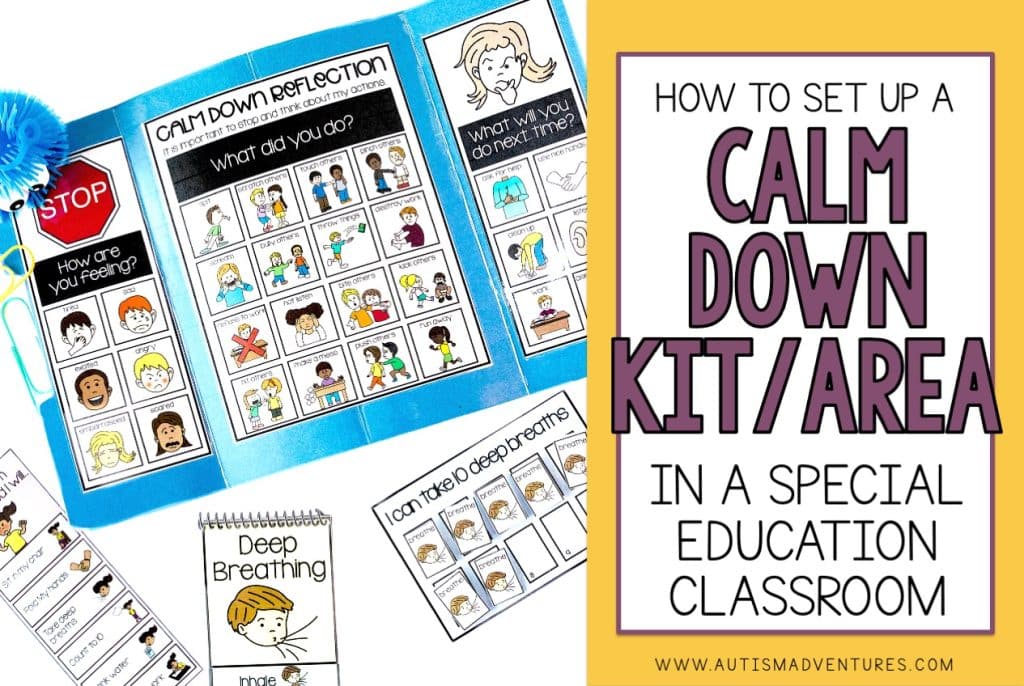
social emotional learning curriculum
Teaching students expected behaviors and social emotional skills is important to create a safe learning environment for students. When setting up your special education program, please consider how you will address the social emotional needs of your students. Social emotional learning plays an important role in schools because it helps equip students with skills outside of academics, builds emotional intelligence and interpersonal skills. School staff work hard to teach the whole child and to create safe learning environment. SEL fosters empathy, understanding and inclusivity within the school setting. Today’s post I am going to talk about social emotional learning curriculum available to you.
If you want to teach expected behaviors to your students and teach various social emotional learning skills, discover the Behavior Basics Program! The Behavior Basics Program can help to create a safe learning environment for your kiddos and to meet the needs of these students.
The Behavior Basics has three components: The Curriculum, The Book Club and The Data Bundle.
The Curriculum provides direct instruction, lesson plans and supplemental materials to teach 60 different behaviors/skills. The Book Club aligns a children’s picture book to each behavior of the Behavior Basics Program and provides reading extension activities. The Data Bundle provides IEP goals and data sheets for easy tracking aligning to each behavior of the Behavior Basics Program.
To learn more about these components, see a detailed preview and get FREE LESSONS, click HERE to read the full post.
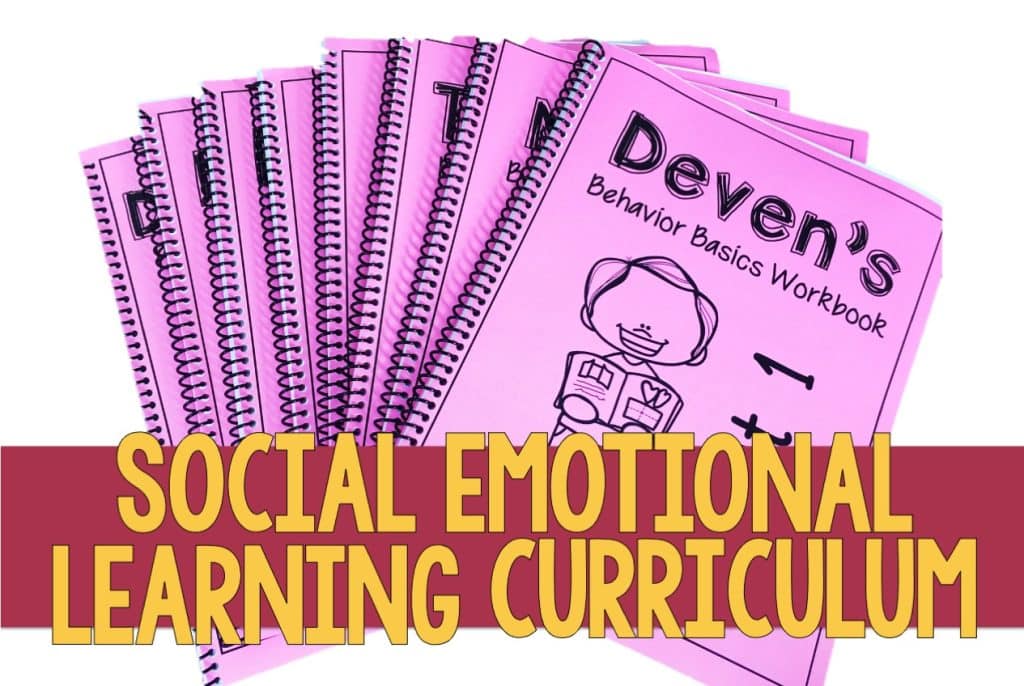
How to Build Effective Communication Skills in the Classroom
Functional communication is one of the most important skills for any student. Being able to communicate basic needs and wants is an essential life skill. It should be a pillar goal for special education teachers when designing their special education program. I have a blog post that teaches you how to build effective communication skills within the classroom across different social settings with the use of visual supports, alternative communication and nonverbal cues. To read the full post, click HERE.
The post outlines non-verbal communication, picture exchange communication systems, assistive technology and an individualized communication device. This post also discusses teaching social skills within the classroom setting. It is important to work with related service providers and service providers to provide speech and language services as stated in student IEPs.
To learn more, click HERE.
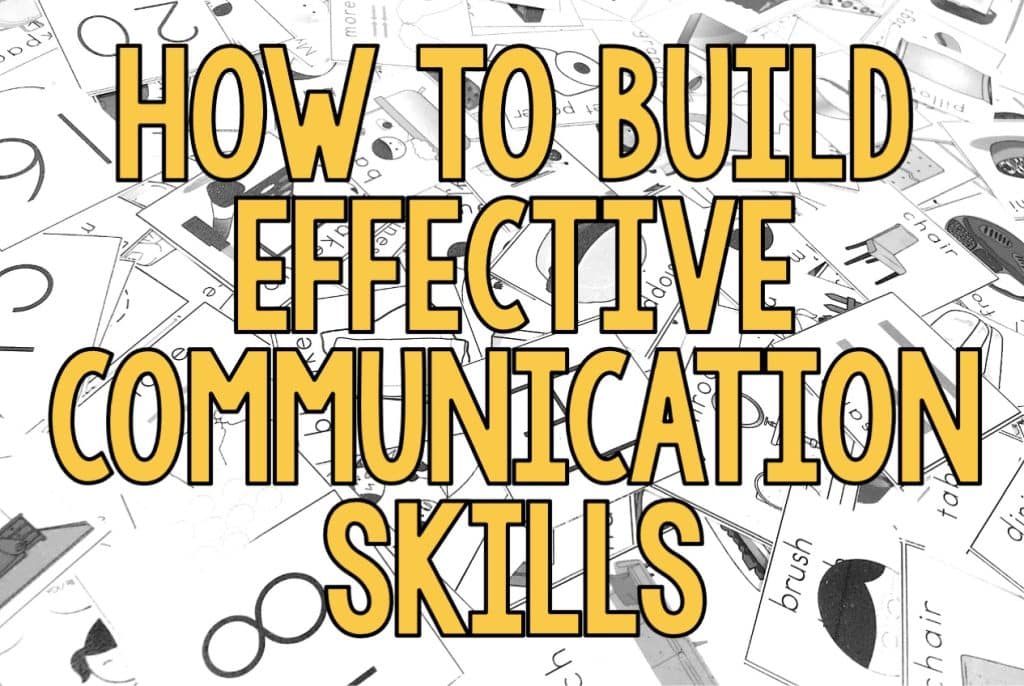
How to Teach Life Skills in a Special Education Classroom
I believe teaching life skills is a crucial part of any special education program. As special education teachers, our goal is to build independence in all areas for our students. There are a variety of life skills components and these will vary depending on the age of your students. Primary grades will focus on toileting, hygiene, personal information and independence while high school students will focus on money skills, vocational skills and cooking skills. Depending on the grade level you teach, and the abilities of your caseload, you will be able to determine which life skills to focus on in your classroom.
Teaching life skills in special education is crucial because it fosters independence and empowers students to manage their daily activities confidently. It equips them with essential tools to navigate real-world challenges, enhancing their overall quality of life. Moreover, life skills instruction helps students develop self-sufficiency, enabling them to participate more fully in their communities.
I have a detailed post about teaching life skills HERE. It outlines:
- Toileting
- Personal Hygiene Needs
- Classroom Jobs
- Learning Personal Information
- Direct Instruction on various Life Skills
To read the full post, CLICK HERE.
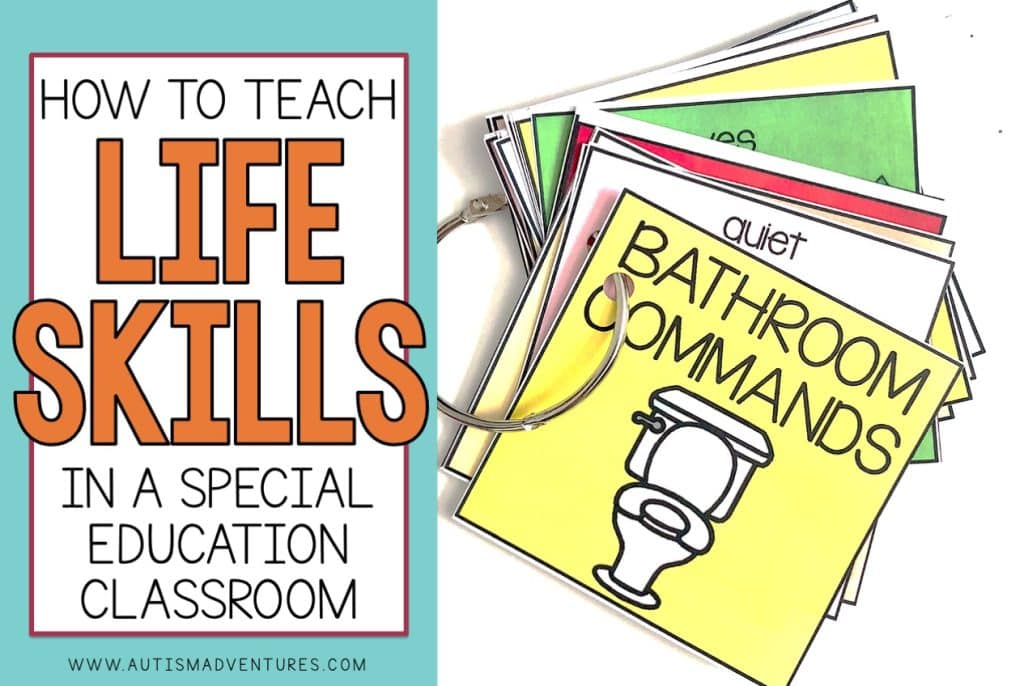
Sensory Integration in the special education classroom
Teaching life skills in special education is crucial because it fosters independence and empowers students to manage their daily activities confidently. It equips them with essential sensory tools to navigate real-world challenges, enhancing their overall quality of life. Moreover, life skills instruction helps students develop self-sufficiency, enabling them to participate more fully in their communities.
My post about sensory integration outlines the 5 senses and how they can present in the classroom, sensory strategies, sensory diets and sensory play in the classroom. It discusses related services and activities that help meet the specific needs of your students. It also provides monthly sensory activity ideas for the classrooms well as a few freebies that can be downloaded from my Free Resource Library.
To read the entire post, click HERE.
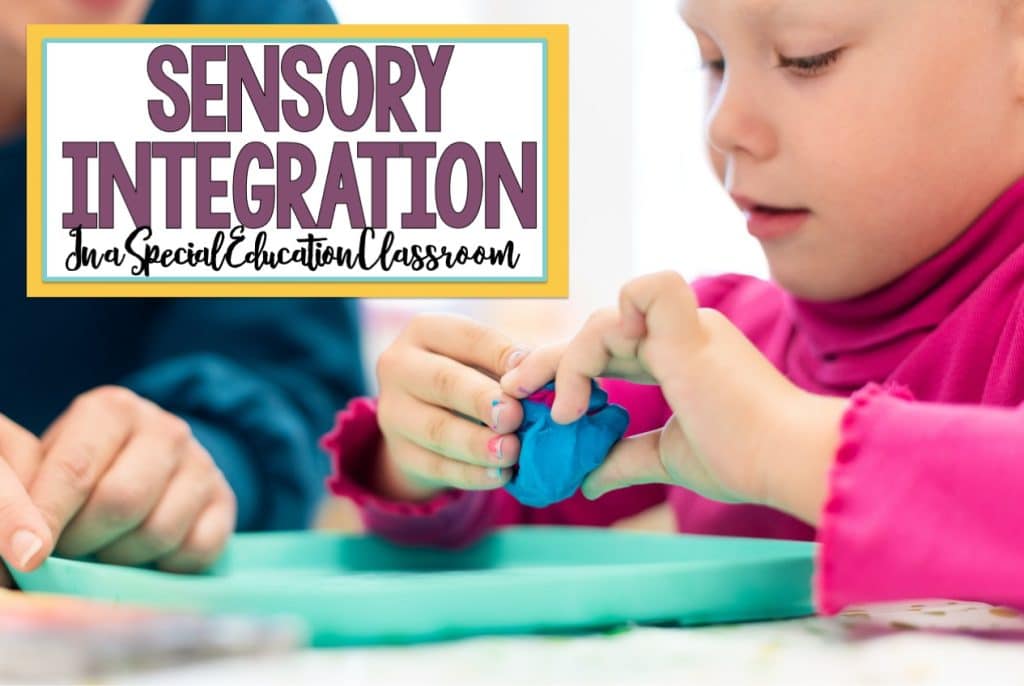
Conclusion
I hope this post has helped you think about your special education classroom setup. My goal with this post was to round up all of my blog posts to help you build an inclusive classroom for your special education students. It is important to take what works for you and modify any ideas that may better suit the needs of the students on your caseload.
Quick Links to All of The Links Blog Posts to help you set up a SPECIAL education classroom
- Classroom Floor Plan- Setting Up A Special Education Classroom
- Best Bulletin Board Ideas for a Special Education Classroom
- Sample Daily Schedule in a Special Education Classroom
- Morning Meeting Routine in a Special Education Classroom
- Calendar Routine in a Special Education classroom
- How to Run Work Center Rotations in a Special Education Classroom
- Visual schedules in a Special Education Classroom
- Visual supports in a special education classroom
- How To Set Up the Best Calm Down Kit for Your Classroom
- Social Emotional Learning Curriculum
- How to Build Effective Communication Skills in the Classroom
- How to Teach Life Skills in a Special Education Classroom
- Sensory Integration in the special education classroom
Like what you read? Don’t forget it, PIN IT!
